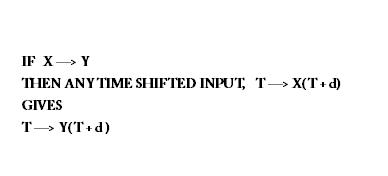(→5.) |
|||
| (2 intermediate revisions by the same user not shown) | |||
| Line 1: | Line 1: | ||
==5.== | ==5.== | ||
Explain in your own words what is a time-invariant system. Give an example of a time-invariant system and “prove” that it is time-invariant. Give an example of a time-variant system and “prove” that it is time-variant. | Explain in your own words what is a time-invariant system. Give an example of a time-invariant system and “prove” that it is time-invariant. Give an example of a time-variant system and “prove” that it is time-variant. | ||
| − | Answer) A time-invariant system is a system which does not depend on time. To explain this, | + | Answer) A time-invariant system is a system which does not explicitly depend on time. To explain this, |
| − | [[ Image | + | [[Image:12_ECE301Fall2008mboutin.jpg]] |
| + | |||
| + | |||
| + | ---- | ||
| + | Example : We have 2 system P and Q, | ||
| + | System P: y(t) = t . x(t) | ||
| + | System Q: y(t) = 5 . x(t) | ||
| + | System P depends explicitly on t but system Q does not; so System Q is not time-invariant but P is time-variant. | ||
| + | A better proof for the very same example can be obtained by time shifting the inputs and outputs. First delay the input by delta(d), then delay separately the output, if they both y(t)'s are equal then the system is time-invariant; and vice versa. | ||
Latest revision as of 15:54, 12 September 2008
5.
Explain in your own words what is a time-invariant system. Give an example of a time-invariant system and “prove” that it is time-invariant. Give an example of a time-variant system and “prove” that it is time-variant.
Answer) A time-invariant system is a system which does not explicitly depend on time. To explain this,
Example : We have 2 system P and Q,
System P: y(t) = t . x(t) System Q: y(t) = 5 . x(t)
System P depends explicitly on t but system Q does not; so System Q is not time-invariant but P is time-variant. A better proof for the very same example can be obtained by time shifting the inputs and outputs. First delay the input by delta(d), then delay separately the output, if they both y(t)'s are equal then the system is time-invariant; and vice versa.


